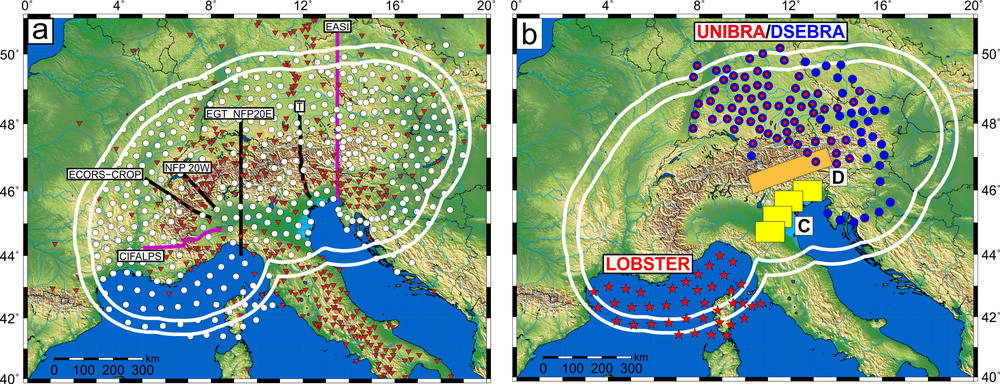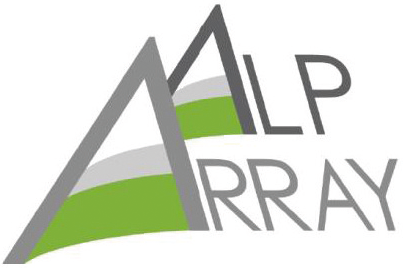A - AlpArray seismological station network (onshore)
The array comprises a network of 579 broad-band seismometers that covers the Alps for several years (end 2015–2019, white lines in Fig. 1). The target volume of this network at the scale of the orogen extends from the surface down to the base of the Mantle Transition Zone (MTZ) at ~660 km depth. The network is broken down into 278 existing, permanent broad-band seismometers of the national networks, 268 mobile land-based seismometers from a multinational pool and 33 off-shore seismometers to be deployed temporarily in the Ligurian Sea (Fig. 1b). The present German contribution to the network (Fig. 1b) includes 24 of the 33 ocean-bottom seismometers (OBS) in the Ligurian Sea (LOBSTER) and 68 land-based stations scraped together in a joint effort by 8 German universities (UNIBRA). The latter has been deployed in the central part of the Alps. From Autumn of 2017 onward, the 68 university stations will be replaced by 100 new land-based stations of DSEBRA; 32 of those stations will be deployed at sites of AlpArray partners.
Landbased stations (Activity A): DSEBRA, "Deutsches (German) Seismological Broadband Array", comprises 100 broad-band, land-based stations dedicated to long-term, dense, large-aperture seismological field experiments. As part of AlpArray, these mobile seismometers fill large gaps in the permanent station network (Fig. 1), and cover the central and eastern parts of the Alps plus the Upper Rhine Graben and the Molasse Basin in southern Germany and Austria. DSEBRA enables AlpArray to image slab geometries and properties, as well as deep structure in the vicinity of the Alps-Dinarides join (Themes 1, 3). This is where the Adriatic and European plates are actively converging, where surface effects are most pronounced (Theme 2) and where seismic hazard and risk are highest (Theme 4).
Figure 1: The Alps and its forelands with locations of AlpArray network and related densified station swaths: (a) White lines delimit the international station network with 579 broad-band seismometers (red triangles – permanent national stations, white circles – AlpArray mobile stations). Purple lines - AlpArray passive seismic swaths with densified station configurations: EASI – Czech-Austria-Swiss swath, CIFALPS – China-Italy-France swath. Black lines – active seismic experiments of the 1980s and 90s, including T, the TRANSALP profile; (b) German seismometers in AlpArray network: Red-blue circles – UNIBRA later replaced by DSEBRA; Blue circles - DSEBRA; Red stars – LOBSTER; Yellow boxes - mobile swath C; Orange rectangle - swath D with densified station networks.



